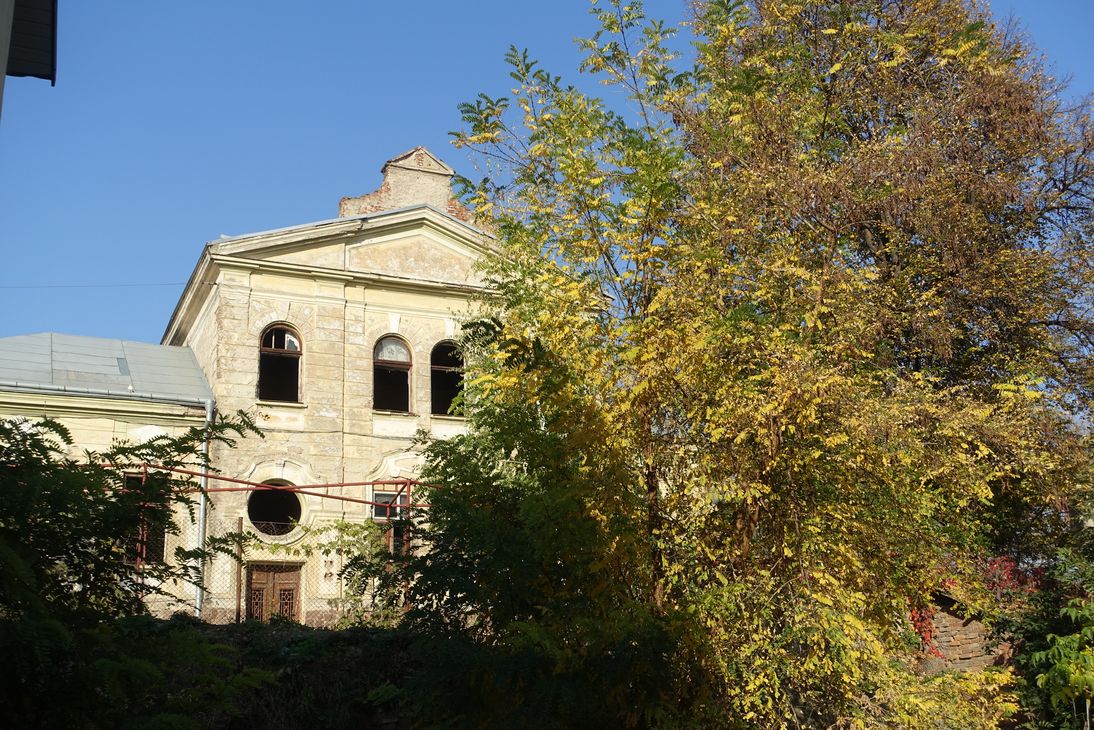Next to the former synagogue “Groise Shil”, you will see another building that is directly connected with the Jewish history of the town. Here, on Synagogue Street #29, there used to be the Israelite Home for the Elderly and Invalid. Next to it was the Jewish hospital. Today, the area is owned by a construction company, and not publicly accessible. One gets the best look at the building standing in front of the entrance to the former synagogue.
The Home for the Invalid and Elderly was the last big project of the Jewish community of Chernivtsi during the Habsburg period. The construction lasted from 1908 until 1911 and was made possible thanks to a generous contribution by Josef Blum, a member of the Bukovinian parliament. The institution continued to operate during the interwar period, when Chernivtsi was part of the Romanian kingdom. In 1940, the Soviet authorities nationalized the building. In 1941, the Home for the Invalid and Elderly, with the adjoining Jewish hospital, was located on the territory of the Chernivtsi Ghetto.
In her interview with Centropa, Sylvia Segenreich, who was born in 1926 in Chernivtsi into a Jewish family, shared her vivid memories of this dramatic time:
My father remained in hiding. My mother was having contractions and I, at 15, had to look after the whole family. Luckily my aunt’s younger son was blond with blue eyes. He put on boots and looked just like an SS officer. Somewhere he found a little cart, put my mother in this cart, and we went to the Jewish hospital. She gave birth there. There, gravely ill people were standing on the street. They had thrown the Jews out of all the hospitals and they were all there. Then I went home alone. There was nothing to eat in the hospital, nothing!
Chernivtsi was under Romanian authority and the Romanians weren’t as bad as the Germans. My Aunt Mania and I went to the Romanian captain; we told him in Romanian, “We are starving to death. Our entire house is filled with Jews, my mother is in the hospital, and the people in the hospital don’t have anything to eat. We know that the Russians left food behind.” The Romanian was very nice and said that we should come at 6am. He would send away the guard standing outside the ice houses and we’d have half an hour to take whatever we could carry. We went with bowls and everyone in the house got something, and I packed some provisions for the hospital. The nurses were anxiously waiting for me. But I wasn’t allowed on the street at this time. I braided my hair, dressed up like a country girl, and went barefoot. That’s how I became the breadwinner. (…) When my sister was born, we did not even have diapers. We tore up bed linens and used them as diapers. My sister was born on July 14, 1941 – five days after my brother had been murdered by the Germans.
After the war the Soviet authorities used the building as a hospital section, which existed until 1996. Due to the danger of landslides and due to the bad condition of the building, the hospital was relocated. In 2000 it became a property of a construction company and unfortunately is not accessible for tourists.
